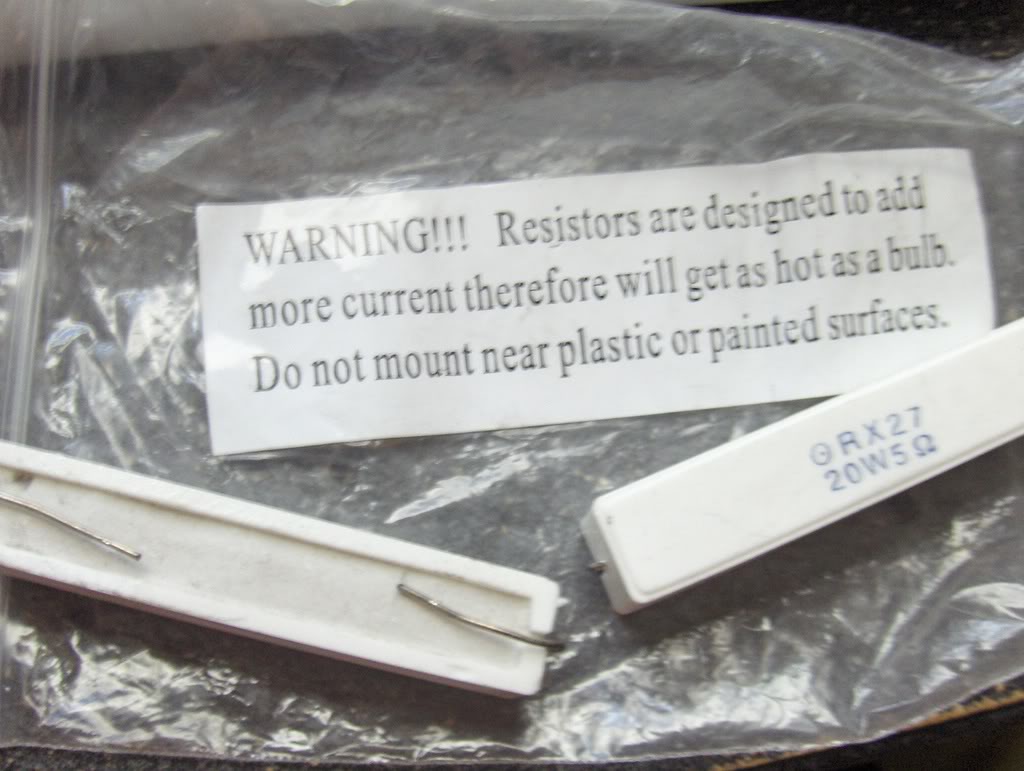What the heck does this thing do for me?
#1
So when I bought my F4 it came with a box of misc. parts. Going through this box last night and I found the OEM taillight, a Clear Alternatives tailight with a busted up lens housing ( so I removed the LED inside), and then at the bottom of the box was this little baggie.
When it comes to electrical stuff, I'm an idiot. It's clearly a resisitor, but I do not know how it works or how it's wired. Could someone tell me? Does it make bulbs brighter? Like a ballast? Can I use it with the LED's I have to make them brighter?

When it comes to electrical stuff, I'm an idiot. It's clearly a resisitor, but I do not know how it works or how it's wired. Could someone tell me? Does it make bulbs brighter? Like a ballast? Can I use it with the LED's I have to make them brighter?

#3
When you replace your regular bulbs (as in turn signals) with LEDs, it draws less current and messes up the blink rate. When you install LEDs the blink rate gets faster. Some people like the faster rate and don't do anything about it, but one way to solve that problem is to install those resistors in line with each blinker...then you slow it back down to the factory blink rate. It's no big deal, really. Most people like the faster rate. But if you do LEDs on both front and rear blinkers than it gets so slow it might not even work properly.
#6
Resistors do just the opposite of ballasts.... instead of increasing voltage, they act as a 'load' and use up voltage. Besides using them to slow down blinkers, another common place to find these (besides printed circuit boards) is in the blower motor resistor pack in your car. The resistor pack has 3 resistors all connected to each other. When you change the fan speed from 1, 2, 3, or 4, it changes how many resistors are used to drop the voltage that gets to the blower motor. On 4, it uses no resistors and gets a full 12v. On 3, only one of the resistors is used, so it drops the voltage to lets say 9v (I'm making up numbers here for example sake) and the blower motor slows down some. On 2, two of the resistors are used to drop the voltage even more to 6v, and the speed drops even more. On 1 all three of the resistors to really limit the voltage and drop it down to 3v and the motor then spins very slowly. This is just an example to help clarify how they work
They're just like any other load though... electric motor, light bulb, solenoid, ect. Only they each have a specific amount of 'resistance', and simply convert this metered amount of electricity into heat (just like the coils on an electric oven), and disperse the heat through their ceramic coating. They're used for the LED's to make up for the lack of resistance from the LED's that the circuit needs to flash at the proper speed. The flash resistors are resistance dependant
They're just like any other load though... electric motor, light bulb, solenoid, ect. Only they each have a specific amount of 'resistance', and simply convert this metered amount of electricity into heat (just like the coils on an electric oven), and disperse the heat through their ceramic coating. They're used for the LED's to make up for the lack of resistance from the LED's that the circuit needs to flash at the proper speed. The flash resistors are resistance dependant
#7
ORIGINAL: therabbit
BWAHAHAHA resistors are designed to add more current. That's gotta be the funniest thing I've read all week, saving that picture for future reference.
BWAHAHAHA resistors are designed to add more current. That's gotta be the funniest thing I've read all week, saving that picture for future reference.
I know they got it a little backwards there... more like "resistors are designed to add more... ummm... RESISTANCE" hahahahah
Thread
Thread Starter
Forum
Replies
Last Post




